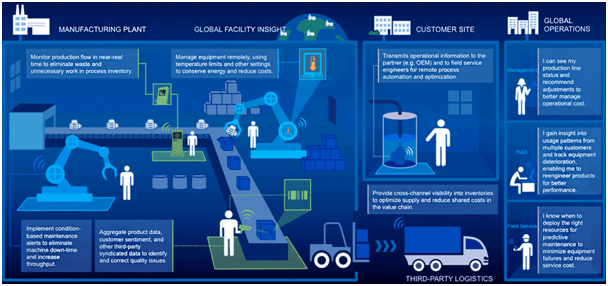With a growing population, urbanization, climate change, consumers’ demands, and limited resources, it is crucial for us to make use of science and technology to change the way we grow, process, preserve and transport our food in a safe and sustainable method.
Agri-food is a complex industry, which is challenging to initiate changes as it includes a wide range of processes, operations, and roles as food travels from the farm to the fork. However, on the other hand, this also creates lots of opportunities for entrepreneurs and technologists to disrupt the industry and create new efficiencies with agri-food tech at various points of the value chain.
In this article, we will examine 4 key emerging technologies that are revolutionizing the Agri-Food sector:
- Internet of Things (IoT) in the Agri-Food Sector
- Robotics in the Agri-Food Sector
- Biotechnology in the Agri-Food Sector
- Vertical Farming in the Agri-Food Sector
Table of Contents
Internet of Things (IoT) in the Agri-Food Sector
The Internet of Things is a network of physical devices that are inter-linked to communicate with each other via the internet, which are capable of reporting status or information of surroundings to increase food traceability, safety, and quality along each stage of the entire food supply chain processes.

Specific use of IoT applications in agriculture allows farmers to have better control or information through devices such as sensors, autonomous vehicles, automated hardware, control systems and drones.
| Applications | Purposes / Usages |
|---|---|
| Precision Farming | • Sensing for soil moisture and nutrients. • Controlling water usage for optimal plant growth. • Determining custom fertilizer profiles based on soil chemistry • Determining the optimal time to plant and harvest. • Reporting weather conditions |
| Agricultural Drones | • Crop health assessment • Irrigation • Crop monitoring & spraying • Planting • Soil and field analysis |
| Livestock Monitoring | • Health data • Location and movement data |
| Smart Greenhouses | • Intelligent climate monitoring • Climate controlling |
Food companies also adopt IoT Technology to improve their factory operations to eliminate waste and unnecessary work through real-time monitoring, as well as analyzing and identify areas that might have potential problems.

Robotics in the Agri-Food Sector
An electro-mechanical device capable of performing tasks automatically without much human intervention, which is paramount importance for the survival of mankind to improve efficiency and food security in Agri-Food sector. The use of Robotics automation in the Agri-Food sector is essential to address competitive challenges by safeguarding future of the business and reducing the impact on environmental degradation.
The 3 Key Features of robotics in Agri-Food:
1. Hygiene
Food safety is importantly required so that our food and beverage products are untouched by humans to eliminate contamination under sterile, human-and-bacteria-free environment. Combining with sanitary design of robotic manipulators, vision systems and end-effectors or grippers to meet stringent requirements in food industry. Industrial detergents and pressurized hot water are used to thoroughly clean the robots’ grippers which are used for food handling application.

2. Productivity
Highly agile robotic structures and the incorporated control schemes with fast operational pick and place speeds help food companies to meet the demand to boost productivity in food preparation, handling and production. The use of robots has surpassed the operator-based manual production rate including warehouse activity of packing and palletizing process through programming standard payload specifications.
3. Workers’ safety
A stringent requirement for standardizing risk hazards in a whole new hybrid Human Robot Interaction (HRI) environment. Example, accessing hazard situations by robots using smart sensor integration and isolate the robot system from the human worker access completely with prevailing concept.
| Applications | Features |
|---|---|
| Pick and Place | • Flexible gripper to handle very delicate foods, even individual lettuce leaves • Delicate handling to avoid damage regardless of variable sizes and shapes, and place products onto trays, cartons or feeding of other machinery |
| Cutting and Slicing | • Detecting and removing defect parts • Uniform cutting shapes and sizes |
| Packing & Palletizing | • Placing of the primary packed product into the secondary packaging which can be cases, trays, crates or shelf ready packaging • Quick and efficient palletizing solutions and offer seamless integration into existing end of line production |
Biotechnology in the Agri-Food Sector
Biotechnology is technology that utilizes biological systems, living organisms or parts of this to develop or create different products.
Modern biotechnology provides breakthrough products and technologies to combat debilitating and rare diseases, reduce our environmental footprint, feed the hungry, use less and cleaner energy, and have safer, cleaner and more efficient industrial manufacturing processes.
The full content is only visible to SIPMM members
Already a member? Please Login to continue reading.
References
Alex Owen-Hill. (2017). “Top 6 Robotic Applications in Food Manufacturing”. Retrieved from https://blog.robotiq.com/top-6-robotic-applications-in-food-manufacturing, accessed 26/08/2018.
Daniel Lin, GDLM. (2018). “New and Emerging Technology in the Port-Logistics Sector”. Retrieved from SIPMM: https://publication.sipmm.edu.sg/new-emerging-technology-port-logistics-sector, accessed 26/08/2018.
CNet. (2018). “Smart Agriculture and Food Production”. Retrieved from http://www.cnet.se/agriculture-food, accessed 25/08/2018.
Data-Flair. (2018). “4 Best Benefits of IoT in Agriculture”. Retrieved from https://data-flair.training/blogs/iot-applications-in-agriculture, accessed 25/08/2018.
Evergreen Farm Oy. (2018) “VERTICAL FARMING”. Retrieved from https://www.evergreenfarm.eu/copy-of-vertical-farming, accessed 31/08/2018.
Food Insight. (2018). “Fact Sheet: Benefits of Food Biotechnology”. Retrieved from https://www.foodinsight.org/articles/fact-sheet-benefits-food-biotechnology, accessed 25/08/2018.
Jamshed IQBAL. (2017). “Prospects of robotics in food industry”. Retrieved from http://www.scielo.br/scielo.php?script=sci_arttext&pid=S0101-20612017000200159, accessed 26/08/2018.
Louisa. (2017). “What is AgriFood Tech?”. Retrieved from https://agfundernews.com/what-is-agrifood-tech.html, accessed 25/08/2018.
Marc Lallanilla. (2016). “GMOs: Facts About Genetically Modified Food”. Retrieved from https://www.livescience.com/40895-gmo-facts.html, accessed 25/08/2018.
Neha Patil. (2017). “Cultured meat”. Retrieved from https://alchetron.com/Cultured-meat#-, accessed 26/08/2018.

